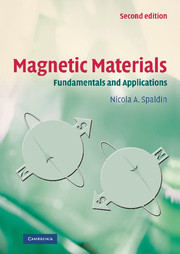Book contents
- Frontmatter
- Contents
- Acknowledgments
- I Basics
- 1 Review of basic magnetostatics
- 2 Magnetization and magnetic materials
- 3 Atomic origins of magnetism
- 4 Diamagnetism
- 5 Paramagnetism
- 6 Interactions in ferromagnetic materials
- 7 Ferromagnetic domains
- 8 Antiferromagnetism
- 9 Ferrimagnetism
- 10 Summary of basics
- II Magnetic phenomena
- III Device applications and novel materials
- Epilogue
- Solutions to selected exercises
- References
- Index
6 - Interactions in ferromagnetic materials
from I - Basics
Published online by Cambridge University Press: 05 June 2012
- Frontmatter
- Contents
- Acknowledgments
- I Basics
- 1 Review of basic magnetostatics
- 2 Magnetization and magnetic materials
- 3 Atomic origins of magnetism
- 4 Diamagnetism
- 5 Paramagnetism
- 6 Interactions in ferromagnetic materials
- 7 Ferromagnetic domains
- 8 Antiferromagnetism
- 9 Ferrimagnetism
- 10 Summary of basics
- II Magnetic phenomena
- III Device applications and novel materials
- Epilogue
- Solutions to selected exercises
- References
- Index
Summary
Anyone who is not shocked by quantum theory has not understood it.
Niels Bohr (1885–1962)In Chapter 2 we introduced the concept of ferromagnetism, and looked at the hysteresis loop which characterizes the response of a ferromagnetic material to an applied magnetic field. This response is really quite remarkable! Look at Figs. 2.3 and 2.4 again – we see that it is possible to change the magnetization of a ferromagnetic material from an initial value of zero to a saturation value of around 1000 emu/cm3 by the application of a rather small magnetic field – around tens of oersteds.
The fact that the initial magnetization of a ferromagnet is zero is explained by the domain theory of ferromagnetism. The domain theory was postulated in 1907 by Weiss and has been very successful. We will discuss the details of the domain theory, and the experimental evidence for the existence of domains, in the next chapter.
The subject of this chapter is: How can such a small external field cause such a large magnetization? In Exercise 6.2(b), you'll see that a field of 50 Oe has almost no effect on a system of weakly interacting elementary magnetic moments. Thermal agitations act to oppose the ordering influence of the applied field, and, when the atomic magnetic moments are independent, the thermal agitation wins.
- Type
- Chapter
- Information
- Magnetic MaterialsFundamentals and Applications, pp. 65 - 78Publisher: Cambridge University PressPrint publication year: 2010
- 1
- Cited by



